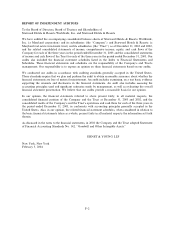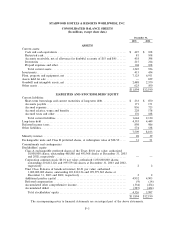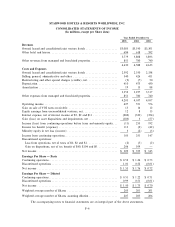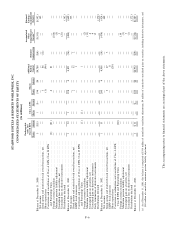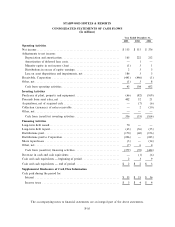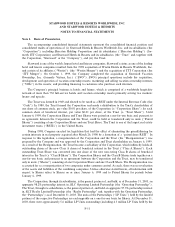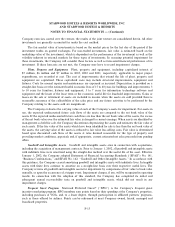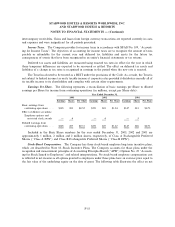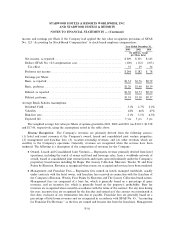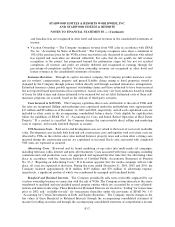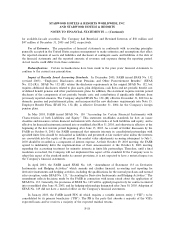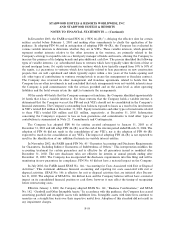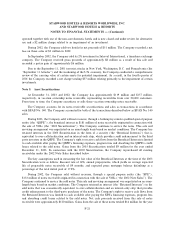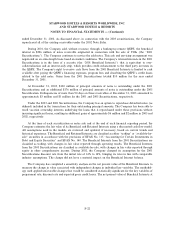Starwood 2003 Annual Report Download - page 78
Download and view the complete annual report
Please find page 78 of the 2003 Starwood annual report below. You can navigate through the pages in the report by either clicking on the pages listed below, or by using the keyword search tool below to find specific information within the annual report.STARWOOD HOTELS & RESORTS WORLDWIDE, INC.
AND STARWOOD HOTELS & RESORTS
NOTES TO FINANCIAL STATEMENTS Ì (Continued)
Corporation). For all periods presented, the LP Units are assumed to have been converted to Shares for
purposes of calculating basic and diluted weighted average Shares outstanding.
Note 2. SigniÑcant Accounting Policies
Principles of Consolidation. The accompanying consolidated Ñnancial statements of the Company and
the Trust and their subsidiaries include the assets, liabilities, revenues and expenses of majority-owned
subsidiaries over which the Company and/or the Trust exercise control, and for which control is other than
temporary. Intercompany transactions and balances have been eliminated in consolidation.
Cash and Cash Equivalents. The Company considers all highly liquid investments purchased with an
original maturity of three months or less to be cash equivalents.
Restricted Cash. Restricted cash primarily consists of deposits received on sales of VOIs that are held in
escrow until a certiÑcate of occupancy is obtained, the legal rescission period has expired and the deed of trust
has been recorded in governmental property ownership records.
Inventories. Inventories are comprised principally of VOIs of $145 million and $137 million as of
December 31, 2003 and 2002, respectively, and hotel operating supplies. VOI inventory is carried at the lower
of cost or net realizable value and includes $3 million, $4 million and $4 million of capitalized interest in 2003,
2002 and 2001, respectively. Operating supplies are generally valued at the lower of cost (Ñrst-in, Ñrst-out) or
market. Potential losses from obsolete and slow-moving inventories are provided for in the current period.
Loan Loss Reserves. For the hotel segment, the Company measures loan impairment based on the
present value of expected future cash Öows discounted at the loan's original eÅective interest rate or the
estimated fair value of the collateral. For impaired loans, the Company establishes a speciÑc impairment
reserve for the diÅerence between the recorded investment in the loan and the present value of the expected
future cash Öows or the estimated fair value of the collateral. The Company applies the loan impairment
policy individually to all loans in the portfolio and does not aggregate loans for the purpose of applying such
policy. For loans that the Company has determined to be impaired, the Company recognizes interest income
on a cash basis.
For the vacation ownership segment, the Company provides for estimated mortgages receivable
cancellations and defaults at the time the VOI sales are recorded with a charge to selling, general
administrative and other expenses. The Company performs an analysis of factors such as economic condition
and industry trends, defaults, past due aging and historical write-oÅs of mortgages and contracts receivable to
evaluate the adequacy of the allowance.
Assets Held for Sale. The Company considers properties to be assets held for sale when management
approves and commits to a formal plan to actively market a property for sale or a signed sales contract exists.
Upon designation as an asset held for sale, the Company records the carrying value of each property at the
lower of its carrying value or its estimated fair value, less estimated costs to sell, and the Company stops
recording depreciation expense. Any gain realized in connection with the sale of properties for which the
Company has signiÑcant continuing involvement (such as through a management or franchise agreement) is
deferred and recognized over the life of the associated involvement (e.g., the life of the related agreement).
Investments. Investments in joint ventures are accounted for using the guidance of Financial Account-
ing Standards Board (""FASB'') Interpretation (""FIN'') No. 46 ""Consolidation of Variable Interest Entities''
for all ventures deemed to be variable interest entities. See additional discussion in the ""Impact of Recently
Issued Accounting Standards'' section to this footnote. All other joint venture investments are accounted for
under the equity method of accounting when the Company has a 20% to 50% ownership interest or exercises
signiÑcant inÖuence over the venture. If the Company's interest exceeds 50% or in certain cases, if the
F-12


